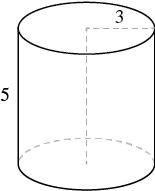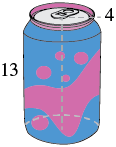If you have ever seen a can of soda, you know what a cylinder looks like. A cylinder is a solid figure with two parallel circles of the same size at the top and bottom. The top and bottom of a cylinder are called the bases. The height [latex]h[/latex] of a cylinder is the distance between the two bases. For all the cylinders we will work with here, the sides and the height, [latex]h[/latex] , will be perpendicular to the bases.
A cylinder has two circular bases of equal size. The height is the distance between the bases.
Volume and Surface Area of a Cylinder
For a cylinder with radius [latex]r[/latex] and height [latex]h:[/latex]

example
A cylinder has height [latex]5[/latex] centimeters and radius [latex]3[/latex] centimeters. Find the 1. volume and 2. surface area.
Solution
| Step 1. Read the problem. Draw the figure and label
it with the given information. |
 |
| 1. |
|
| Step 2. Identify what you are looking for. |
the volume of the cylinder |
| Step 3. Name. Choose a variable to represent it. |
let V = volume |
| Step 4. Translate.
Write the appropriate formula.
Substitute. (Use [latex]3.14[/latex] for [latex]\pi [/latex] ) |
[latex]V=\pi {r}^{2}h[/latex]
[latex]V\approx \left(3.14\right){3}^{2}\cdot 5[/latex] |
| Step 5. Solve. |
[latex]V\approx 141.3[/latex] |
| Step 6. Check: We leave it to you to check your calculations. |
|
| Step 7. Answer the question. |
The volume is approximately [latex]141.3[/latex] cubic inches. |
| 2. |
|
| Step 2. Identify what you are looking for. |
the surface area of the cylinder |
| Step 3. Name. Choose a variable to represent it. |
let S = surface area |
| Step 4. Translate.
Write the appropriate formula.
Substitute. (Use [latex]3.14[/latex] for [latex]\pi [/latex] ) |
[latex]S=2\pi {r}^{2}+2\pi rh[/latex]
[latex]S\approx 2\left(3.14\right){3}^{2}+2\left(3.14\right)\left(3\right)5[/latex] |
| Step 5. Solve. |
[latex]S\approx 150.72[/latex] |
| Step 6. Check: We leave it to you to check your calculations. |
|
| Step 7. Answer the question. |
The surface area is approximately [latex]150.72[/latex] square inches. |
example
Find the 1. volume and 2. surface area of a can of soda. The radius of the base is [latex]4[/latex] centimeters and the height is [latex]13[/latex] centimeters. Assume the can is shaped exactly like a cylinder.
Answer:
Solution
| Step 1. Read the problem. Draw the figure and
label it with the given information. |
 |
| 1. |
|
| Step 2. Identify what you are looking for. |
the volume of the cylinder |
| Step 3. Name. Choose a variable to represent it. |
let V = volume |
| Step 4. Translate.
Write the appropriate formula.
Substitute. (Use [latex]3.14[/latex] for [latex]\pi [/latex] ) |
[latex]V=\pi {r}^{2}h[/latex]
[latex]V\approx \left(3.14\right){4}^{2}\cdot 13[/latex] |
| Step 5. Solve. |
[latex]V\approx 653.12[/latex] |
| Step 6. Check: We leave it to you to check. |
|
| Step 7. Answer the question. |
The volume is approximately [latex]653.12[/latex] cubic centimeters. |
| 2. |
|
| Step 2. Identify what you are looking for. |
the surface area of the cylinder |
| Step 3. Name. Choose a variable to represent it. |
let S = surface area |
| Step 4. Translate.
Write the appropriate formula.
Substitute. (Use [latex]3.14[/latex] for [latex]\pi [/latex] ) |
[latex]S=2\pi {r}^{2}+2\pi rh[/latex]
[latex]S\approx 2\left(3.14\right){4}^{2}+2\left(3.14\right)\left(4\right)13[/latex] |
| Step 5. Solve. |
[latex]S\approx 427.04[/latex] |
| Step 6. Check: We leave it to you to check your calculations. |
|
| Step 7. Answer the question. |
The surface area is approximately [latex]427.04[/latex] square centimeters. |
 Rectangular solids and cylinders are somewhat similar because they both have two bases and a height. The formula for the volume of a rectangular solid, [latex]V=Bh[/latex] , can also be used to find the volume of a cylinder.
For the rectangular solid, the area of the base, [latex]B[/latex] , is the area of the rectangular base, length × width. For a cylinder, the area of the base, [latex]B[/latex], is the area of its circular base, [latex]\pi {r}^{2}[/latex]. The image below compares how the formula [latex]V=Bh[/latex] is used for rectangular solids and cylinders.
Seeing how a cylinder is similar to a rectangular solid may make it easier to understand the formula for the volume of a cylinder.
Rectangular solids and cylinders are somewhat similar because they both have two bases and a height. The formula for the volume of a rectangular solid, [latex]V=Bh[/latex] , can also be used to find the volume of a cylinder.
For the rectangular solid, the area of the base, [latex]B[/latex] , is the area of the rectangular base, length × width. For a cylinder, the area of the base, [latex]B[/latex], is the area of its circular base, [latex]\pi {r}^{2}[/latex]. The image below compares how the formula [latex]V=Bh[/latex] is used for rectangular solids and cylinders.
Seeing how a cylinder is similar to a rectangular solid may make it easier to understand the formula for the volume of a cylinder.
 To understand the formula for the surface area of a cylinder, think of a can of vegetables. It has three surfaces: the top, the bottom, and the piece that forms the sides of the can. If you carefully cut the label off the side of the can and unroll it, you will see that it is a rectangle. See the image below.
By cutting and unrolling the label of a can of vegetables, we can see that the surface of a cylinder is a rectangle. The length of the rectangle is the circumference of the cylinder’s base, and the width is the height of the cylinder.
To understand the formula for the surface area of a cylinder, think of a can of vegetables. It has three surfaces: the top, the bottom, and the piece that forms the sides of the can. If you carefully cut the label off the side of the can and unroll it, you will see that it is a rectangle. See the image below.
By cutting and unrolling the label of a can of vegetables, we can see that the surface of a cylinder is a rectangle. The length of the rectangle is the circumference of the cylinder’s base, and the width is the height of the cylinder.
 The distance around the edge of the can is the circumference of the cylinder’s base it is also the length [latex]L[/latex] of the rectangular label. The height of the cylinder is the width [latex]W[/latex] of the rectangular label. So the area of the label can be represented as
The distance around the edge of the can is the circumference of the cylinder’s base it is also the length [latex]L[/latex] of the rectangular label. The height of the cylinder is the width [latex]W[/latex] of the rectangular label. So the area of the label can be represented as
 To find the total surface area of the cylinder, we add the areas of the two circles to the area of the rectangle.
To find the total surface area of the cylinder, we add the areas of the two circles to the area of the rectangle.
 The surface area of a cylinder with radius [latex]r[/latex] and height [latex]h[/latex], is
[latex-display]S=2\pi {r}^{2}+2\pi rh[/latex-display]
The surface area of a cylinder with radius [latex]r[/latex] and height [latex]h[/latex], is
[latex-display]S=2\pi {r}^{2}+2\pi rh[/latex-display]



